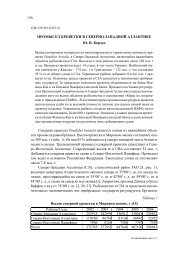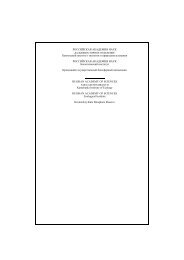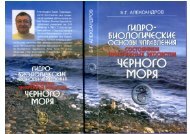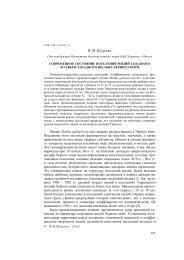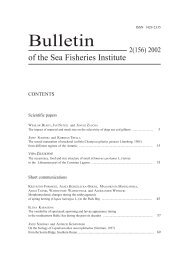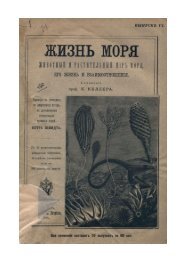Bulletin of the Sea Fisheries Institute 2 (153) 2001 - CEEMaR
Bulletin of the Sea Fisheries Institute 2 (153) 2001 - CEEMaR
Bulletin of the Sea Fisheries Institute 2 (153) 2001 - CEEMaR
Create successful ePaper yourself
Turn your PDF publications into a flip-book with our unique Google optimized e-Paper software.
BULLETIN O THE SEA ISHERIES INSTITUTE<br />
2 (<strong>153</strong>) <strong>2001</strong><br />
Main phytoplankton assemblages in <strong>the</strong> Gulf <strong>of</strong> Gdañsk<br />
and <strong>the</strong> Pomeranian Bay from 1994 to 1997<br />
S³awomira Gromisz and Zbigniew Witek<br />
<strong>Sea</strong> isheries <strong>Institute</strong>, Ko³³¹taja 1, 81-332 Gdynia, Poland<br />
Abstract. The comparison <strong>of</strong> <strong>the</strong> phytoplankton composition <strong>of</strong> 156 samples collected during 11<br />
cruises in <strong>the</strong> Gulf <strong>of</strong> Gdañsk and <strong>the</strong> Pomeranian Bay based on clustering analyses led to <strong>the</strong><br />
identification <strong>of</strong> ten algae assemblages at a similarity lower than 50%. The most distinct phytoplankton<br />
assemblages were found in samples collected at stations located directly near <strong>the</strong> Vistula<br />
River mouth and a local, single-species assemblage formed by din<strong>of</strong>lagellate Peridiniella catenata<br />
in <strong>the</strong> Gulf <strong>of</strong> Gdañsk. O<strong>the</strong>r assemblages were relevant to subsequent seasons <strong>of</strong> <strong>the</strong> vegetative<br />
cycle: winter-spring, summer and autumn.<br />
The relationship <strong>of</strong> <strong>the</strong> phytoplankton assemblage with environmental conditions (low salinity,<br />
high nutrient concentrations) was <strong>the</strong> most evident near <strong>the</strong> Vistula River mouth. In o<strong>the</strong>r areas,<br />
phytoplankton composition changed seasonally and was mainly correlated with temperature, and/<br />
or day length. The differences in phytoplankton composition between <strong>the</strong> Gulf <strong>of</strong> Gdañsk and <strong>the</strong><br />
Pomeranian Bay were relatively small at a similarity higher than 50%.<br />
Key words: phytoplankton, Baltic <strong>Sea</strong>, estuary, assemblages, diversity<br />
INTRODUCTION<br />
The Gulf <strong>of</strong> Gdañsk and <strong>the</strong> Pomeranian Bay are both <strong>of</strong> significant importance in <strong>the</strong> functioning<br />
<strong>of</strong> <strong>the</strong> Baltic ecosystem. The Vistula River mouth is located in <strong>the</strong> Gulf <strong>of</strong> Gdañsk, and is<br />
second only to <strong>the</strong> Newa River in <strong>the</strong> volume <strong>of</strong> freshwater it contributes to <strong>the</strong> Baltic <strong>Sea</strong><br />
(approximately 34 km 3 /year). The largest river mouth in <strong>the</strong> western region <strong>of</strong> <strong>the</strong> Baltic <strong>Sea</strong> is<br />
that <strong>of</strong> <strong>the</strong> Oder, which contributes approximately 18 km 3 <strong>of</strong> freshwater annually. The nutrient<br />
load carried by <strong>the</strong>se two rivers comprises a significant portion <strong>of</strong> <strong>the</strong> total nutrient input to <strong>the</strong><br />
Baltic <strong>Sea</strong>. or example, <strong>the</strong> 1995 loads <strong>of</strong> total nitrogen and total phosphorus from both <strong>the</strong><br />
Vistula and Oder Rivers was 25% and 33%, respectively, <strong>of</strong> <strong>the</strong> total input <strong>of</strong> <strong>the</strong>se elements to<br />
<strong>the</strong> Baltic <strong>Sea</strong> from all land sources (excluding atmospheric input; HELCOM 1998).<br />
Although <strong>the</strong> areas <strong>of</strong> <strong>the</strong> two basins are similar (Gulf <strong>of</strong> Gdañsk – about 5,000 km 2 ,<br />
Pomeranian Bay – about 6,000 km 2 ), <strong>the</strong>ir topography and functioning differ. The Gulf <strong>of</strong><br />
Gdañsk is a relatively deep basin with a maximum depth <strong>of</strong> 117 m. It is permanently stratified<br />
(halocline at depths <strong>of</strong> about 70-90 m) and organic matter accumulates in its sediments and



